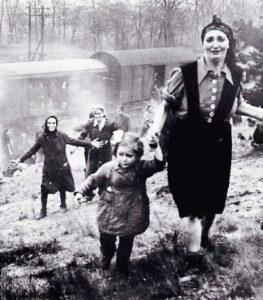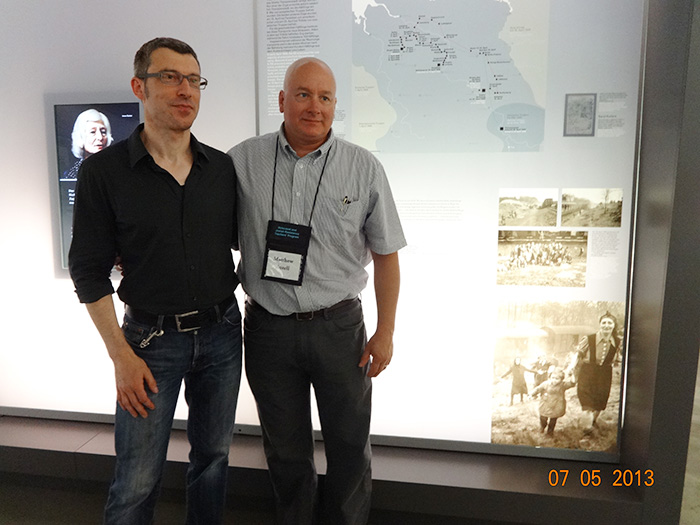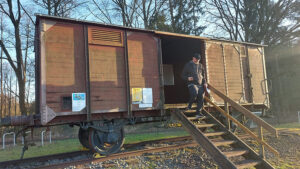By Matthew Rozell, Special to The Chronicle
Editor’s note: First of a 3-part series.
Last month, I finally got to travel to historical sites in Germany and France where events that occurred 16 years before I was born helped to shape my adult life — experiences chronicled in my 2016 book, A Train Near Magdeburg.
It was revelatory on many levels.
Film director Michael Edwards of Columbus, Ohio, and his crew documented this journey for an upcoming film based on the book. The documentary has been in the works for several years. This trip had been put on hold because of the pandemic.
Over the next three weeks leading up to Memorial Day, I’ll share my odyssey following in the footsteps of liberating American soldiers, culminating in my visits to sacred sites of remembrance including Omaha Beach and the American Cemetery at Normandy.
We also followed the victims of the Holocaust — from the horrors of Camp Bergen-Belsen to the 1,200-year-old German city of Magdeburg on the Elbe River, where we pinpointed the actual location of the now famous liberation photograph seen on the cover of my book.
We interviewed German students and their teacher who, upon coming across my work and realizing that this had happened in their backyard, took it upon themselves to interview German eyewitnesses to the train, invite back survivors, and help create an exhibition and memorial to this event in their hometown.
The momentous picture

As a high school history teacher in Hudson Falls, beginning 25 years ago, I led an oral history project to collect the stories of local World War II veterans, that we have since donated to the Veterans Oral History Project at the NYS Military Museum. Those stories also became the backbone for multi-book oral history series, The Things Our Fathers Saw.
The interview that got me curious about this liberated train was with one veteran, retired NYS Supreme Court Justice Carrol ‘Red’ Walsh, who had almost forgotten to tell me about in our two-hour long conversation until prompted by his daughter Elizabeth Connelly as I was ready to pack up: ‘Dad, did you tell Mr. Rozell about that train? That was an interesting story.’
How picture was taken
In early April 1945, Nazi Germany was reeling as the western Allies attacked, and the Red Army closed in from the East, following 10 months of almost non-stop combat since D-Day.
On Friday, April 13, 1945, two tanks were ordered by their major to investigate an apparently stranded train transport that had civilians milling about it.
The GIs were in a somber mood; they had just received word that FDR, their president, was dead.
They were on the road to fight what would turn out to be one of the last major battles of the European war at Magdeburg, Germany, 15 miles distant.
In the next few days, many of these young men would themselves be dead.
But in this moment, what to make of this train, halted in the middle of nowhere?
Their major had his jeep driver stop when the train, in the bottom of a slight ravine, came into fuller view. He stood up and snapped a photograph — as it happens, this was the instant the people realized they were liberated.
Later, the original photo and other other photographs of the day were filed away in a dresser drawer, where they lay for decades until my interviews with the soldiers in 2001. Today, that first photo is acknowledged as one of the most iconic photos of the 20th century
At Bergen-Belsen camp
Our recent trip is a climax of forces set into motion following that one interview I conducted nearly 21 summers ago.
Director Mike Edwards and I started in Germany, first stop Bergen-Belsen.

We were greeted warmly by Bernd Horstmann and his colleague Stephanie, who secured permission for us to tour and film the exhibition and Memorial grounds.
Bernd is the official “Custodian of the Book of Names.” Among his duties is to reconstruct the log destroyed by the German SS before they handed over the camp, with its 60,000 starving and disease-ridden victims of the Holocaust, to British soldiers on April 15.
Records show that 800 victims died on that day alone.
In all, 120,000 people passed through here. The Bergen-Belsen Memorial today is a mass grave cemetery, most of the victims unknown. Pursuing his never-ending task in this one camp, Bernd and his German historian colleagues are up to about 53,000 souls now identified.
In April 1945, Belsen was a literal scene of horror, but today no structures remain. A concrete gutter channel runs into the woods. A looming obelisk beckons in the foreground, drawing us past meticulously maintained mounds embedded with their baleful inscriptions:
HIER RUHEN 800 TOTE APRIL 1945
HIER RUHEN 1000 TOTE APRIL 1945
HIER RUHEN 2500 TOTE APRIL 1945
Translated: Here rest eight hundred dead. A thousand dead. Twenty-five hundred, dead. April, 1945.
‘Walked in their footsteps’
The film crew and I walked to the expansive railhead where prisoners arrived and some were fortunate enough eventually to depart, like those on our train.
For this, we needed special permission; it is in a restricted NATO military base area — the British only left here in 2015.
We have prior interviews with survivors who recounted that 7 km walk, wondering if they were walking to their deaths. Agi and Leslie, quoted below, became good friends. Sadly, both have since passed away.
Old and young were killed when they stumbled and fell, they told us; others, as they tried to get food.
It was such an honor to walk in their footsteps that afternoon into evening. We finished the shoot close to 8 p.m.
Stolen beets
Teenage survivor Agi Baker recounted, “I remember well. The stack of dead, the stack of skeletons. My father was dead by that time. Then came that day, I had my 10th birthday in Bergen-Belsen.
“The kapo said, ‘We are moving out in five minutes.’ It was a hilly road, up and down. When you see the couple thousand people that we were, you see the beginning [of the forced march], we were about in the middle, and I remember I kept asking my mother, ‘Are they shooting yet?’, because I was sure that they’re going to get rid of us on the way there.
“At that point I don’t remember being scared, it was just matter of fact.”
We interviewed Leslie Meisels, who was just 17, but the man of the family: “When we arrived at the railyard and were ordered to climb up into the wagon, I had seen an open rail car loaded with red beets (cattle feed).
“Even though we knew that the punishment would be terrible, some people went there and got a few pieces, because a red beet like this was enough for four people, like my mother, my two brothers, and myself, to sustain us, raw as it was, for a day. I asked for one of the pillowcases, which was our main carrying case, from my mother, for her to empty it, give it to me. I shuffled over there, put in a half dozen beets or so, and was carrying it back.
“When I arrived back to our freight car, an SS guard with his back to me was aiming and shooting to death a 10 or 11-year-old little boy who had two red beets, one in each hand. While he was shooting that little boy to death, I was able to hand my bundle to someone who gave it to my mother. When he turned around, he just barked at me to get up. Would he have turned around 10 or 15 seconds earlier, I wouldn’t be speaking here to you.
“Those red beets were the only food in the days while we were on the train. The stench was indescribable. When you needed to go to that five-gallon pail, which was already overflowing, it was too late. The other [bucket] with our water was already empty. It was horrible, screaming, crying, all the noise which ill-treated human beings were giving up.”
Six nights, seven days
The prisoners were crammed in the train on April 6, forced to stay overnight before the engineer got permission to move out to another concentration camp in Czechoslovakia. They would be on the rail for six nights and seven days, suffering through stops and starts, changing course with the Allied air raids; many more died on the journey.
At this very railhead

So here we were, at this very railhead where the survivors boarded the train, destination and fate unknown to them.
A small railcar remains at this closed off spot as a memorial, with mementos of remembrance. We filmed in silence as the shadows grew long before heading back to our hotel for the next day’s journey to the site of liberation. As we left, a single high caliber gunshot rang out, punctuating our meditations at this spot in a most telling and dramatic way.
The journey that took the starving prisoners seven days took us about an hour and a half. In our comfortable rented cars, we were on our way to Magdeburg, and the site of liberation. The time had come for me to be present there, Walsh and Gross had told me about — that occurred 77 years earlier, exactly to the day — and to meet the German students and their teacher who had since stepped up to keep the memory alive.
NEXT: TO MAGDEBURG and the site of salvation, 77 years to the day of liberation; interviewing German eyewitnesses and teens; finding the resting place of a girl whose death haunted the GIs.
Copyright © 2022 Lone Oak Publishing Co., Inc. All Rights Reserved
 Glens Falls Chronicle Serving the Glens Falls/Lake George region; Warren, Washington and northern Saratoga counties since 1980
Glens Falls Chronicle Serving the Glens Falls/Lake George region; Warren, Washington and northern Saratoga counties since 1980

